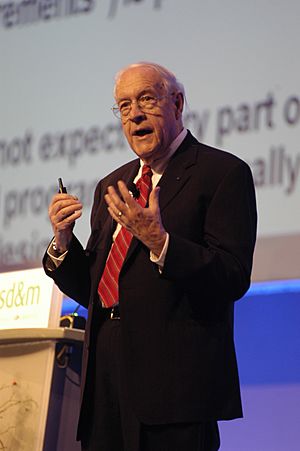Fred Brooks facts for kids
Quick facts for kids
Fred Brooks
|
|
|---|---|

2007 photo
|
|
| Born |
Frederick Phillips Brooks Jr.
April 19, 1931 Durham, North Carolina, US
|
| Died | November 17, 2022 (aged 91) |
| Alma mater | |
| Known for | OS/360 The Mythical Man-Month |
| Spouse(s) | Nancy Greenwood Brooks |
| Children | Kenneth, Roger, Barbara |
| Awards |
|
| Scientific career | |
| Fields | Computer science Operating systems Software engineering |
| Institutions | IBM University of North Carolina at Chapel Hill Duke University Harvard University |
| Thesis | The Analytic Design of Automatic Data Processing Systems (1956) |
| Doctoral advisor | Howard Aiken |
| Doctoral students | Andrew S. Glassner |
Frederick Phillips "Fred" Brooks Jr. (born April 19, 1931 – died November 17, 2022) was an important American computer scientist. He was known for his work in designing computers and creating software.
Fred Brooks led the team that developed IBM's System/360 computers. He also managed the creation of the OS/360 software that ran these machines. Later, he wrote a famous book called The Mythical Man-Month. This book shared his experiences and lessons learned from managing big software projects.
In 1976, he became a member of the National Academy of Engineering. This was because of his great work in computer system design. He also helped create computer science programs at universities. Brooks received many honors, including the National Medal of Technology in 1985 and the Turing Award in 1999.
Contents
Education and Early Life
Fred Brooks was born in Durham, North Carolina. He went to Duke University and earned a science degree in physics in 1953. Later, he studied at Harvard University. In 1956, he received his Ph.D. (a very high degree) in applied mathematics, which included computer science. His teacher there was Howard Aiken.
While at Harvard, Brooks was a teaching assistant for Ken Iverson. This was for a new program called "automatic data processing," which was one of the first computer science programs in the world.
Career and Computer Innovations
Brooks started working at IBM in 1956. He helped design powerful computers like the IBM 7030 Stretch and the IBM 7950 Harvest. These were very advanced machines for their time.
Later, he became the manager for the IBM System/360 computer family. He also oversaw the creation of the OS/360 software package. During this time, he came up with the term "computer architecture." This term describes how a computer system is designed and how its parts work together.
Founding a Computer Science Department
In 1964, Fred Brooks moved to the University of North Carolina at Chapel Hill. He started the university's computer science department and led it for 20 years. Even in 2013, he was still doing research there. He focused on virtual environments and scientific visualization. This means creating computer-generated worlds and showing complex data visually.
The Mythical Man-Month
After leaving IBM, Brooks wrote his famous book, The Mythical Man-Month. The idea for the book came from IBM's CEO, Thomas Watson Jr.. He asked Brooks why managing software projects was so much harder than managing hardware projects.
In his book, Brooks shared a very important idea: "Adding manpower to a late software project makes it later." This is now known as Brooks's law. It means that bringing more people onto a project that is already behind schedule often makes it even slower. This is because new people need time to learn, and communication becomes harder.
Brooks also wrote another important paper called No Silver Bullet – Essence and Accident in Software Engineering. This paper discussed that there's no single, easy solution to all software problems.
A Key Decision: The 8-bit Byte
In interviews, Fred Brooks was asked about his greatest technical achievement. He said it was changing the IBM 360 series from using 6-bit "bytes" to 8-bit bytes. This change allowed computers to use lowercase letters and many more characters. This small change had a huge impact on how computers handled information worldwide.
A special "20th anniversary" edition of The Mythical Man-Month was published in 1995. It included four new chapters. Besides this book, Brooks wrote or co-wrote many other books and papers. These include Automatic Data Processing, No Silver Bullet, Computer Architecture, and The Design of Design.
His work on how people interact with computers is also very important. You can find details about his contributions on Ben Shneiderman's HCI pioneers website.
Service and Important Roles
Fred Brooks served on several important national boards and committees in the United States. He was part of the Defense Science Board and chaired the Military Software Task Force. He also served on the National Science Board. These roles showed his commitment to helping the country with technology and science.
Awards and Honors
Fred Brooks received many awards for his groundbreaking work in computer science:
- He became a Fellow of the Institute of Electrical and Electronics Engineers (IEEE) in 1968.
- He received the National Medal of Technology and Innovation in 1985. This is one of the highest honors given by the U.S. President for technological achievement.
- In 1993, he was awarded the IEEE John von Neumann Medal.
- He received the Turing Award in 1999, which is often called the "Nobel Prize of computing." This award recognized his contributions to computer architecture and software engineering.
- In 2001, he became a member of the National Academy of Sciences.
- He also received the Computer History Museum's Fellow Award in 2001.
In 2005, he gave the Turing Lecture about "Collaboration and Telecollaboration in Design." In 1994, he was recognized as a Distinguished Fellow of the Association for Computing Machinery.
Personal Life
Fred Brooks was an evangelical Christian. He was actively involved with InterVarsity Christian Fellowship. He named his oldest son after his former teacher, Kenneth E. Iverson.
See also
 In Spanish: Frederick Brooks para niños
In Spanish: Frederick Brooks para niños

